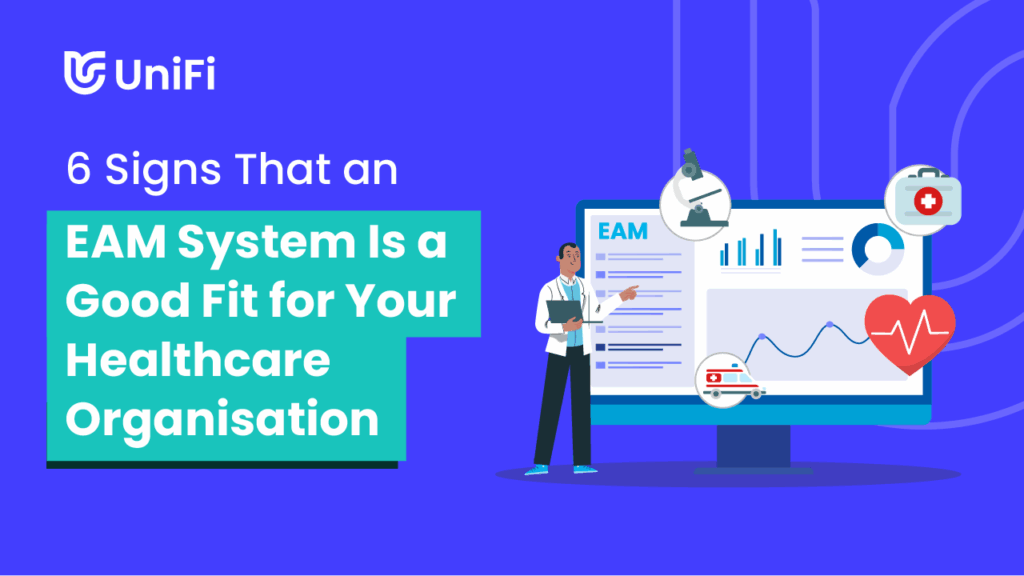As healthcare organisations continue to shift towards value-based care models, the importance of effective asset management has become increasingly apparent.
Healthcare assets, such as medical equipment and facilities, are essential to delivering quality care and can significantly impact patient outcomes.
That’s why more and more hospitals and clinics are investing in Enterprise Asset Management (EAM) systems to help them manage their assets more effectively.
But how do you know if an EAM system is the right fit for your medical institution?
Here are five signs that a healthcare asset management system is a good fit for your organisation.
Sign #1: Interoperability and Standards Compliance
Interoperability with other healthcare systems and adherence to industry standards are crucial for seamless data exchange.
Ensure that the EAM system complies with relevant standards such as HL7 (Health Level Seven), DICOM (Digital Imaging and Communications in Medicine), and FHIR (Fast Healthcare Interoperability Resources).
Additionally, look for support for standard data exchange protocols and APIs (Application Programming Interfaces) to facilitate integration with third-party systems and future-proof your investment.
For instance, UniFi comes with powerful integration capabilities, including advanced APIs.
This allows you to connect to third-party applications and retrieve data for use on a form either to populate an external dropdown (e.g., a list of suppliers, patience, etc.) or to put data into an external calculated field (e.g., retrieve a budget or forecast figure).
Sign #2: Integration with IoT and Predictive Maintenance
As healthcare facilities become increasingly digitised, integrating Internet of Things (IoT) technology into asset management processes is becoming essential.
Look for an EAM system that supports IoT sensors and devices for real-time asset performance and condition monitoring.
Predictive maintenance capabilities, powered by IoT data and analytics, can help healthcare organisations identify potential equipment failures before they occur, enabling proactive maintenance and minimising disruptions to patient care.
Sign #3: Scalability and Future-Proofing
As your medical organisation grows and evolves, your EAM system should be able to scale with you.
If the system offers scalability to accommodate changes in asset volume and organisational structure over time, it is likely a good fit.
Additionally, look for a vendor that is committed to innovation and staying ahead of industry trends.
A good EAM system will receive regular updates and enhancements to adapt to changing technology and regulatory requirements, ensuring long-term viability and return on investment for your organisation.
Sign #4: Security and Data Protection:
Protecting sensitive patient data and ensuring data security are top priorities for any healthcare facility.
Choose an EAM system that adheres to industry best practices for data security, including encryption, role-based access controls, and audit trails.
The system should also comply with relevant data protection regulations such as GDPR (General Data Protection Regulation) and provide data backup and disaster recovery to safeguard against data loss or breaches.
Sign #5: Advanced Reporting and Analytics
Data is at the heart of any successful healthcare organisation.
A good EAM system should offer comprehensive reporting features and interactive dashboards, allowing you to monitor key performance indicators (KPIs), track asset performance, and make informed decisions.
Advanced analytics features such as predictive maintenance modelling and financial forecasting can further enhance operational efficiency and asset reliability.
Sign #6: Customisation for Healthcare Needs
An Enterprise Asset Management system for healthcare should offer a high degree of configurability to ensure it aligns with your organisation’s unique requirements.
Look for tailored functionalities such as support for medical equipment maintenance schedules, compliance with healthcare regulations, and integration with other healthcare systems like Electronic Health Record (EHR).
A sound EAM system for hospitals will allow you to customise workflows and data fields specific to healthcare assets and processes, ensuring seamless integration with existing workflows.
Conclusion
An Enterprise Asset Management system can significantly benefit healthcare organisations, from improving patient outcomes to reducing costs to ensuring compliance.
By evaluating your organisation’s needs and looking for the right features and integrations, you can find a system that’s a good fit for your medical organisation and helps you achieve your goals.
Want a great EAM system for your health organisation? Book a free demo to see UniFi EAM in action!



